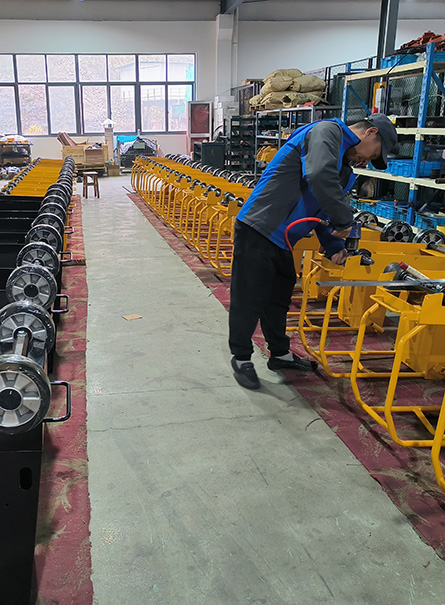What is the Reversible Plate Compactor
A reversible plate compactor features a shaft rotating with an eccentric rotor, allowing for adjustable force phases based on the shaft's rotation. This mechanism enables control over both force and speed. With twin eccentric weights, these compactors exert significant compaction forces, akin to the impact of an 80kg tamping rammer. Operators can adjust the forward, neutral, and reverse actions, including their direction and speed, making the machine versatile and stable. This type of compactor is particularly effective for tasks like sewerage backfill and broader construction projects.
The reversible vibratory plate compactor offers the flexibility of forward and reverse operations, making it suitable for compacting trenches and backfilling around foundations. These machines can also perform stationary spot compaction. Reversible plate compactors are often used for deeper sub-base compaction due to their high-performance and heavy-duty nature.
Soil Compaction and Plate Compactors
Can plate compactors compress soil effectively? For most landscaping projects, a single-directional vibratory plate is commonly employed. These compactors are available for rent at many equipment rental outlets. However, compaction of soil with cohesive materials is a specific case.
Plate compactors come in various types and sizes. They operate by repeatedly vibrating or driving a flat metal plate against the ground. This action compresses and smoothens rough or uneven terrain. Sand and gravel are optimal soil types for these machines. Despite this, many paving contractors opt for plate compactors to compress asphalt in smaller areas where larger, ride-on rollers are impractical.
Essentials of a Reversible Plate Compactor
A reversible plate compactor stands out in its ability to alter compaction direction and intensity. It operates with a rotating shaft and an eccentric rotor, allowing adjustable force and speed. The compactor generates strong forces, comparable to an 80kg tamping rammer, thanks to its twin eccentric weights. Its design includes variable forward, neutral, and reverse motions, enhancing its adaptability and stability, making it particularly effective for extensive tasks such as sewerage backfill.
This type of compactor is versatile, ideal for trench compaction and foundation backfilling, and can also perform stationary spot compaction. Often used for deep sub-base compaction, reversible plate compactors are a go-to choice for high-performance and heavy-duty tasks.
Regarding soil compaction, landscapers typically use a single-directional vibratory plate for granular materials like sand and soil. However, cohesive materials like silt and clay are better compacted using a vibrating rammer. Plate compactors, available for rent at many equipment companies, are effective on granular ground, like gravel and sand, and are also used for compacting asphalt in confined spaces.
Plate compactors function by vibrating a flat metal plate against the ground, effectively compressing and smoothing uneven surfaces. Ideal for sand and gravel, these compactors are also employed by paving contractors for asphalt compaction in areas inaccessible to larger rollers.
What you can use a plate compactor for
Using a plate compactor accelerates the compaction process, ensuring a solid base for landscaping and paving projects. It's particularly efficient for creating stable foundations for driveways and pathways, ensuring safety and evenness.
A plate compactor operates by exerting force and reducing air voids in the ground, with a high-frequency vibrating plate aiding movement. The operator guides the machine, which naturally progresses along the work area.
Different types of plate compactors are suited for various tasks and ground materials. Selecting the right type is crucial for efficiency and effectiveness.
- Single Plate Compactor: Best for smaller areas, these require forward steering and are ideal for landscaping and path-making.
- Reversible Plate Compactor: Suitable for larger jobs and heavy-duty tasks, offering time-saving benefits and efficient compaction, especially for materials needing more weight.
Tamping Rammer Usage
Tamping rammers are smaller, suited for patch jobs and trenches with cohesive soil, requiring downward force for effective compaction. They are hand-held and need to be steered upright.
Choosing the Right Compactor
Selecting the appropriate compactor involves considering the ground material type, the force rating, width, and weight of the compactor. The correct choice depends on whether you're working with cohesive or granular ground, and the specific requirements of the compaction task.
Using a Reversible Plate Compactor
Operating a reversible plate compactor involves:
- Turning on the ignition and setting the throttle.
- Adjusting the forward/reverse lever as needed.
- Guiding the compactor across the area, reversing direction at the end of each line.
Using a Tamping Rammer
To use a tamping rammer:
- Turn on the ignition and set the throttle.
- Engage the choke and start the engine.
- Steer the rammer around the area, ensuring even compaction.
Safety in Compaction Equipment Usage
Safety is paramount when using compaction equipment. Always wear appropriate protective gear, check the machine's condition, ensure a clear workspace, and use the equipment with care and attention.
Common Questions About Compactors
- Compacting Dirt: Plate compactors can compact various types of dirt, but it's important to assess the dirt type and moisture content for effective compaction.
- Wetting Gravel: While not always necessary, slightly wetting gravel can help reduce dust during compaction.
- Using on Pavers: A plate compactor can settle pavers, but care must be taken not to use overly powerful equipment that could damage them.


